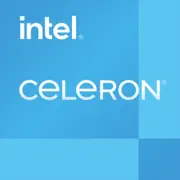Intel Celeron N5095

Intel Celeron N5095: Budget Processor for Everyday Tasks
Overview of Architecture, Performance, and Use Cases
1. Architecture and Process Technology: Efficiency First
The Intel Celeron N5095 processor, released as part of the Jasper Lake lineup, is designed for budget laptops and compact devices. Its architecture is based on a 10nm process (Intel 10nm SuperFin), providing a balance between performance and energy efficiency.
- Cores and Threads: 4 cores (Tremont) and 4 threads. Hyper-Threading is absent, so each core handles only one thread.
- Frequencies: Base frequency is 2.0 GHz, maximum in turbo mode is 2.9 GHz. However, due to low TDP (6W), turbo boosting is available only for short bursts.
- Cache: L3 cache is 4MB. This is sufficient for light tasks, but multithreaded applications may run into limitations.
- Integrated Graphics: Intel UHD Graphics (Jasper Lake) with 16 Execution Units (EUs). Supports 4K H.265/VP9 video decoding and output on two displays. Not suitable for gaming—only older games at low settings (e.g., CS:GO at 720p will yield 20-25 fps).
Architecture Highlights:
- Emphasis on energy efficiency — Tremont cores are optimized for low-power devices.
- Support for PCIe 3.0 and USB 3.2 Gen 2 — relevant for connecting external drives.
2. TDP and Power Consumption: Quiet and Cool
The processor's TDP is 6W. This allows for passive cooling (no fans) in devices such as:
- Ultraportable laptops (e.g., ASUS ExpertBook B1).
- Mini PCs (Chuwi LarkBox X).
- Windows tablets.
Advantages of Low TDP:
- No noise.
- Lower heating — prolongs the life of components.
- Compatibility with compact cases.
Disadvantages:
- Limited performance in resource-intensive tasks.
3. Performance: What Can the Celeron N5095 Do?
Benchmark results (Geekbench 6):
- Single-Core: 503 points.
- Multi-Core: 1449 points.
Real-World Scenarios:
- Office Work:
- Working with documents (Word, Excel), browsing (10-15 tabs), Zoom meetings— the processor handles it, but running all tasks simultaneously may lead to stutters.
- Example: Lenovo IdeaPad 1 laptop (8GB RAM, SSD) — price $250–$300.
- Multimedia:
- Playing 4K video (via YouTube or local files) — smooth thanks to hardware decoding.
- Photo editing in Lightroom — basic edits are possible, but exporting will take 2-3 times longer than on a Core i5.
- Gaming:
- Only lightweight games: Minecraft (30-40 fps on minimum settings), Stardew Valley, browser games.
Turbo Mode:
Maximum frequency (2.9 GHz) activates under load on 1-2 cores. For example, when opening a browser or launching an app. In multithreaded scenarios (rendering, archiving), the frequency drops to 2.2–2.4 GHz due to TDP limitations.
4. Use Cases: Who is this Processor Suitable For?
The Celeron N5095 is a choice for those who value battery life and low cost. Ideal users include:
- Students: For note-taking, online courses, lecture viewing.
- Office Workers: Working with email, documents, spreadsheets.
- Home Users: Surfing the internet, streaming Netflix.
Not Suitable For:
- Gamers.
- Video editors.
- Programmers working with heavy IDEs.
5. Battery Life: Up to 10 Hours of Operation
Low power consumption allows laptops with the Celeron N5095 to operate up to 8-10 hours under moderate load (screen brightness 50%, Wi-Fi on).
Energy-Saving Technologies:
- Intel Speed Shift: Dynamic frequency management.
- C-states: Disabling unused cores.
- Display Power Saving: Reducing screen power consumption.
Example: Acer Aspire 3 laptop with a 45Wh battery — 9 hours in PDF reading mode.
6. Comparison with Competitors
AMD Athlon Silver 3050U (Zen, 15W TDP):
- Better multithreaded performance (2 cores/4 threads).
- Higher price ($350–$400).
Intel Pentium Silver N6000 (Jasper Lake):
- Frequencies up to 3.3 GHz, but TDP 10W — requires active cooling.
- Costs $50–$70 more.
Apple M1 (in MacBook Air):
- Not competitive on price, but shows how much higher performance can be with similar TDP.
Conclusion: Celeron N5095 is the most affordable option but comes with a compromise in speed.
7. Pros and Cons
Strengths:
- Low device cost ($200–$350).
- Passive cooling — complete silence.
- Support for 4K video.
Weaknesses:
- Slow performance in multitasking.
- Not suitable for gaming and professional tasks.
- Limited upgrade options (often non-removable RAM).
8. Laptop Selection Recommendations
Types of Devices:
- Ultrabooks: For example, HP 14-dk1000 — weight 1.4 kg, 14" screen.
- Chromebooks: ASUS Chromebook Flip C214 — optimization of Chrome OS compensates for the weak CPU.
Key Considerations:
- Display: Full HD is preferable to HD (avoid 1366x768).
- SSD: Essential! An HDD will slow down even basic tasks.
- RAM: Minimum of 8GB.
Examples of 2025 Models:
- Lenovo IdeaPad Slim 3: $279, 8GB/256GB, 15.6" FHD.
- Dell Inspiron 15 3520: $299, 8GB/512GB, touch screen.
9. Final Conclusion: Who is this Processor for?
The Intel Celeron N5095 is an optimal choice for:
- Budget Laptops under $300.
- Devices with Long Battery Life.
- Users who do not require high performance.
Key Benefits:
- Savings on purchase.
- Quiet operation.
- Sufficient power for basic tasks.
If you're looking for a laptop for studies, text processing, or watching series — the Celeron N5095 will do the job. However, for gaming, editing, or programming, consider more powerful options.
Basic
CPU Specifications
Memory Specifications
GPU Specifications
Miscellaneous
Benchmarks
Compared to Other CPU
Share in social media
Or Link To Us
<a href="https://cputronic.com/en/cpu/intel-celeron-n5095" target="_blank">Intel Celeron N5095</a>